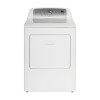Haier HLTD500AEW User Manual - Page 16
Exhaust Hood
 |
View all Haier HLTD500AEW manuals
Add to My Manuals
Save this manual to your list of manuals |
Page 16 highlights
Recommended Maximum Exhaust Length Exhaust Hood Types Recommended Use Only For Short Run Installations 4" (10.2 cm) dia. 4" (10.2 cm) dia. 4" (10.2 cm) 4" (10.2 cm) dia. 2½" (6.4 cm) No. of 90° Elbows Rigid Metal Rigid Metal 0 90 feet 60 feet 1 60 feet 45 feet 2 45 feet 35 feet 3 35 feet 25 feet r All joints should be tight to avoid air leaks. The male end of each section of ducting must point away from the dryer. r Use clamps or duct tape to connect and seal all joints. Do not connect with screws or other fasteners that extend into the interior of the duct as they will create a collection point for lint. Clamp r Avoid running the exhaust system through an unheated area as this will cause condensation to form inside the duct and increase the rate of lint accumulation. r Avoid running the exhaust system vertically through a roof as this may expose the exhaust system to down drafts, causing an increase in air restriction. r Avoid sagging, compression or crimping of the exhaust system as this will result in reduced airǍow and poor dryer performance. r Do not screen the end of the exhaust system. Lint will accumulate and eventually clog the screen. Use an approved exhaust hood to terminate the duct outdoors. r The total length of Ǎexible metal duct shall not exceed 2.4 m (7.8 ft). EXHAUST HOOD r Use an approved exhaust hood with a swing-out damper that opens when the dryer is in operation. When the dryer stops, the damper automatically closes to prevent drafts and the entrance of insects and rodents. r Louvered or box hood styles are recommended. Angled hood styles are acceptable, but should be used only for short run installations. See the "Recommended Maximum Exhaust Length" chart for more information. r To avoid restricting airǍow, maintain a minimum of 12" (30.5 cm) clearance between the vent hood and the ground or any other obstruction. 14















